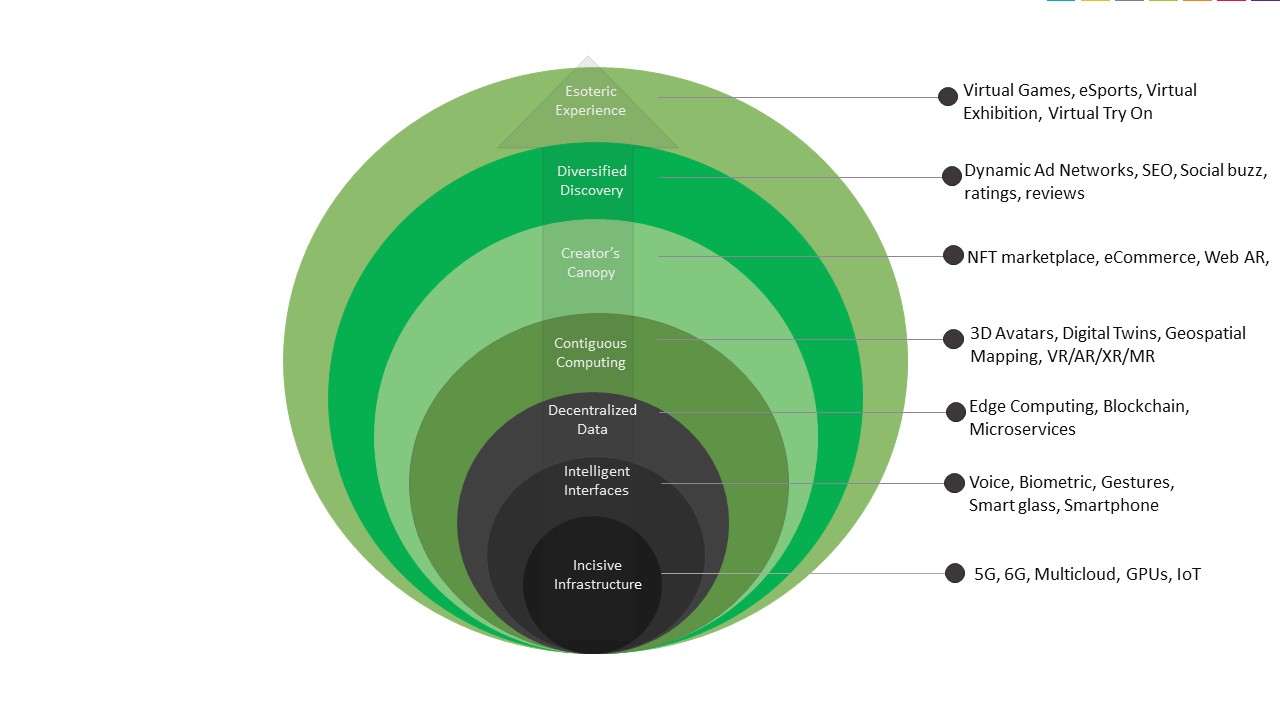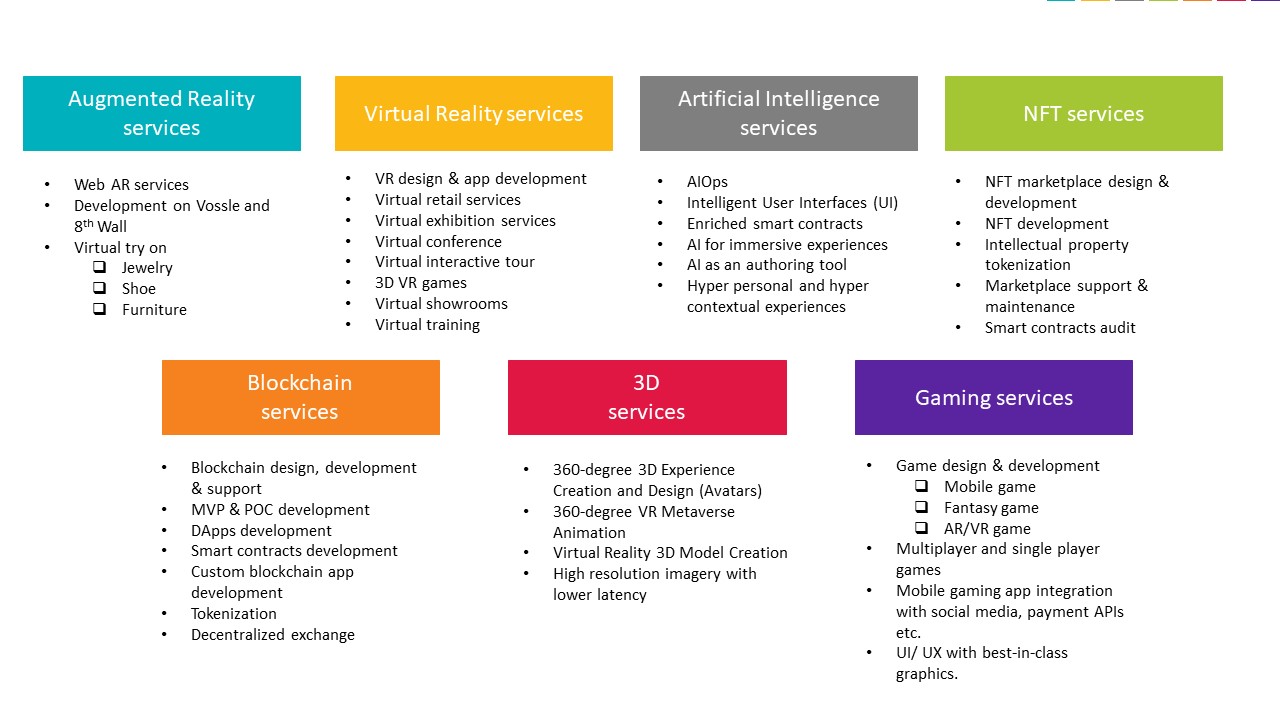It’s a Sunday afternoon and after an early lunch, Mike, a Gen Z video game lover, was “deeply immersed” within a VR kit, making his digital avatar win his favorite video game on Nintendo Switch. While he plays the survival game, many “in-game” billboards with ads for pizza, warm beverages, and “take a break” catch his attention. As digestive enzymes trigger his hunger, Mike goads his father into buying pizzas, who does so, not physically but by scanning through one of the “in-game” billboards with his smartphone while the payment is done from the bitcoin balance Mike had earned by playing the game. With orders placed, a happy Mike continues playing while the pizza is on his way home. Having gorged on his pizza after some time, Mike, an efficient guitar player with an active account on SoundCloud virtual, gets down to compose something new, and once done, he simply uploads the recorded piece onto Soundcloud Virtual as an NFT. Mike and his friends keep trading their NFTs between them, like a mutual appreciation club transferring bitcoins with glee and feeling appreciated for their compositions, the very bitcoins that they earn playing video games.
That was a Sunday well spent on the “Metaverse”.
Metaverse- The next big promise in the digital world
The Metaverse, the digital world’s Next Big Promise, is being seen as a parallel “3D virtual world” where each human being gets to own an avatar as an identity. These animated avatars would be capable of virtually doing all sorts of real-world activities in virtual worlds, from shopping to gaming to traveling to owning and selling real estate. For now, some tech-savvy couples have hosted their marriage and reception parties in the Metaverse. How cool is that!
Gartner defines a Metaverse as a collective virtual shared space created by the convergence of virtually enhanced physical and digital reality. It is persistent, providing enhanced immersive experiences, as well as device-independent, and accessible through any type of device, from tablets to head-mounted displays. It also predicts that by 2026, 25% of people will spend at least one hour per day on the Metaverse.
While majority around the globe are still coming to terms with Metaverse and all that it encapsulates, early investments by pioneers like Meta (the company), Fortnite (the game), Somnium Space (a VR world builder), IMVU (an avatar-based 3D social network) and many others have swollen the Metaverse market size to about $47bn (with around $10bn out of this committed by Meta itself) with predicted market size of around $800bn by 2024. We are talking of a 16 times growth rate within the next 2-3 years, which is mind-numbingly mammoth.
Building blocks of metaverse- What comprises this evolving magical world?
Mike’s Sunday afternoon with which we started this piece encapsulates all the key building blocks of metaverse:

Figure: Building blocks of Metaverse
Let’s evaluate each of the building blocks:
- Augmented reality (AR): Pokémon Go showed us the beauty of augmented reality some years back. Thereafter, many popular brands like Ikea showed us how augmented reality can help people visualize product placements in their living rooms even before they purchase them. In the Metaverse, AR will play an active part in differentiating brands, low-cost visualization of costly assets, enabling virtual try-on (of make-up, shoes, jewelry, etc.), for immersive gamified experience, enriched quality assurance, etc.In Mike’s story, the way his dad scans the virtual pizza banner from within the game to buy Mike some real-world pizzas is a good example of “AR in action”. The AR market, in keeping with the larger Metaverse phenomenon, is expanding at a rapid rate and is poised to touch $88.4bn by 2026 from $14.7bn in 2020.
- Virtual reality (VR): Virtual reality is the use of computer technology for creating a simulated environment. An immersive and interactive virtual reality allows the audience to interact with the experience, turning them into active participants. In a virtual setup, the participant can turn around, jump up, bend down, look up, move around, and do anything that he/she would in the real world. Use cases of virtual reality applications saw a quantum growth during the pandemic with virtual conferences, virtual games, virtual exhibitions, virtual events, virtual training, virtual computer vision, and interactive virtual tours seeing widespread traction. Virtual games have truly pushed the demand meter on VR and in Mike’s story, his VR headsets played a key role in providing him with an immersive experience. The global virtual reality headsets market size is projected to reach USD19. 8 Billion by 2026, from USD 6.8 Billion in 2020, at a CAGR of 19.5%.
- Artificial intelligence (AI): Artificial intelligence (AI) has become a key ingredient in digitalization across industries- be it retail, manufacturing, healthcare, or any other. Whether machine learning, deep learning, business intelligence, natural language processing (NLP), or AI-powered chatbots, enterprises are better served with insights and analytics, courtesy of AI. In the Metaverse, AI plays a role in every step of the way. From AIOps at an infrastructural plane, enabling blockchain-driven smart contracts to power data-driven immersive experiences across various digital interfaces, to hyper-personalizing experiences at the top, AI is a vital cog in the wheel of the Metaverse. In Mike’s story, the fact that he paused at the pizza banner and a sale was made would be captured and used in the ad algorithms going ahead. The global artificial intelligence market size was valued at USD 51.08 Billion in 2020 and is projected to reach USD 641.30 Billion by 2028, growing at a CAGR of 36.1%.
- Non-fungible tokens (NFT): NFTs are tokens used to represent ownership of unique items. Several celebrities like Reese Witherspoon, Eva Longoria, Serena Williams, etc. have used NFT profile pictures on Twitter. NFTs allow creators to tokenize things like art, collectibles, even real estate. “Non-fungible” means it’s unique and can’t be replaced with something else. For example, currency is fungible — can exchange one $100 note for another. But NFTs are one of a kind and can be bought by users directly from the creators. Hence, it has the special aura of something prized and unique. For every such NFT sold, creators can earn without depending on any intermediary. Mike and his friends share each of their creative compositions as NFTs and even buy and sell them using bitcoins. The global non-fungible token (NFT) market size reached USD 340.0 Million in 2020 and is expected to register a rapid revenue CAGR in the forthcoming years.
- Blockchain services: It wouldn’t be inappropriate to say that blockchain would be a popular trading medium on the Metaverse; while Metaverses will most certainly allow for buying and selling using real currencies too, blockchain would make the experience much more disintermediated, seamless, and secure. Blockchain will also form the basis of Decentralized Apps (DApps) and Decentralized Autonomous Organizations (DAO). The blockchain market size is projected to grow from USD 4.9 billion in 2021 to USD 67.4 billion by 2026.
- 3D modelling: 3D modelling refers to the development process of mathematical representation of a particular surface of any object in 3 dimensions by using advanced level software. With avatars set to represent each human entity on the Metaverse, and virtual exhibitions, virtual events, and shows becoming prominent uses cases in the Metaverse, the demand for 3D artists is growing like never before across industries, such as animation, film, gaming, architecture, and interior designing. Mike’s pleasing and motivating avatar in his video game results from some good 3D design. 3D mapping and modeling market size was valued at USD 3.64 Billion in 2020 and is projected to reach USD 13.15 Billion by 2028.
- Game design, development, and commercialization: With more than 2.7 billion gamers around the world and around 48% of gaming companies working on AR/VR games, the estimated size of the gaming industry is in the range of $200bn globally and is poised to reach $545.88 by 2028 with a CAGR of 13.2%.
Gaming companies like Roblox and Epic Games are leading the way in building metaverses by building virtual worlds, where millions of gamers interact, play, and take part in an experiential economy. Some pro-gamers even make a living inside these Metaverses by selling their digital collectibles. Some companies like Roblox also held their holiday parties in the Metaverse while companies like Fortnite treated their fans to a Travis Scott concert.
Metaverse brings together the experience economy
The biggest property of Metaverse is bringing together various dimensions of “Experience Economy”. Experience is a function of the right infrastructure with intelligent interfaces that supports decentralized existence of data closer to devices while enabling consumption of immersive experiences, thus encouraging the creator community to compose and publish innovative pieces of work in the form of NFTs, which when discovered through multifaceted marketing results in esoteric experiences which is unprecedented. Such experiences, in turn, produce massive units of data that get fed back into the loop to create a continuum of the experience economy. The below illustration explains this loop.

Figure: The esoteric Experience Economy
Metaverse as a service (MaaS) is taking off already
This whole decentralized, permission-less, semantic web-oriented, AR/VR/XR/MR/AI-driven, hyper-connected, and ubiquitous nature of the Metaverse opens it to a myriad of business uses across industries. The sheer potential of this now nascent industry is forcing many technology leaders like Meta, Google, BMW, Nissan, and many others to not only invest in this but also compels many IT companies to package this as a service where they can actually go ahead and create metaverses for their clients. The industry is expected to grow 16 times in the next 3-4 years and, as always, early movers would get the cream of the cake. But what would a metaverse service catalog look like? While we evaluated the building blocks earlier in this piece, each such building block will have a myriad of services under it. Each such service area is vast in nature and possibly the subsequent blogs will look to deep dive into a prominent few services. But the fact remains that this ever-growing catalog of Metaverse possibilities needs to be packaged “as a service” and offered to the market at the earliest, as the sheer revenue potential cannot be overlooked. Let’s take a look at a sample metaverse catalog with a scope of many more services that can get added in the coming years.

Figure: The evolving Metaverse service catalog
Security on metaverse will be key to its growth
Metaverse is still at its genesis phase and already concerns are being raised about potential security loopholes that could drain away its usefulness. One concern being raised is that of “Avatar Impersonation”- a kind of potential identity theft of Metaverse, where an unwanted element can hack into the Metaverse and manipulate the avatars for shady gains. To combat this, experts are mulling to build biometrics into the hardware so that the VR headset can recognize and record the iris of the person and associate it with his/her avatar to prevent such social engineering.
Invisible avatar eavesdropping is another potential security breach that’s coming to the fore where disruptive elements may invisibly join meetings and listen to the conversations. Likewise, most recently Facebook identified a few users complain of sexual harassment on the Metaverse and hence brought about the “personal boundary” tool to make users feel like they have nearly four feet between their virtual avatar and others when they access the immersive Horizon Worlds and Horizon Venues apps through VR headsets.
As the metaverse ecosystem expands, it is equally important for cyber security experts to conceptualize potential security threats and create mitigation measures for each to make the metaverse as safe and secure as possible.
Conclusion
The world started talking about the Metaverse in the summer of 2021 when Facebook CEO Mark Zuckerberg started off his plan to focus his company on building what he imagined would be the future of social, business, leisure, and culture: the metaverse. He, later on, changed the name of his company from Facebook to Meta. Since then, this space has stayed abuzz with activities with several big technology players investing, ideating, exploring the future of the 3D virtual world in this “parallel” verse. Many have started visualizing “Metaverse as a Service” as a service offering by bringing together the myriad building blocks of AR, VR, AI, blockchain, NFTs, 3D, and gaming together. This is a fast-growing space, and it is imperative that the IT industry watches this space closely, stitches in the right partnerships, conducts a few rapid POCs and MVPs, and then rolls out a full-fledged Metaverse as a Service (MaaS) proposition. It may not be long when requests for responses are solicited as NFTs and due diligence are conducted through virtual networks. The promise is immense, and it will be important for all the stakeholders to come together to identify valuable use cases and leverage the opportunities in Metaverse to its complete might while ensuring the security is held tight at all times.
This article originally appeared in HCL Tech.













Great article Ved, and it stimulated a vision for me in the Brand Personalization space. I saw a Metaverse as a service platform that would create a virtual brand character for my brand. This brand character would greet customers in the virtual space and serve the customer with personalized experience to help them shop and purchase what they wanted. Imagine Siri in the Metaverse as a virtual character.
Great article Ved, and it stimulated a vision for me in the Brand Personalization space. I saw a Metaverse as a service platform that would create a virtual brand character for my brand. This brand character would greet customers in the virtual space and serve the customer with personalized experience to help them shop and purchase what they wanted. Imagine Siri in the Metaverse as a virtual character.